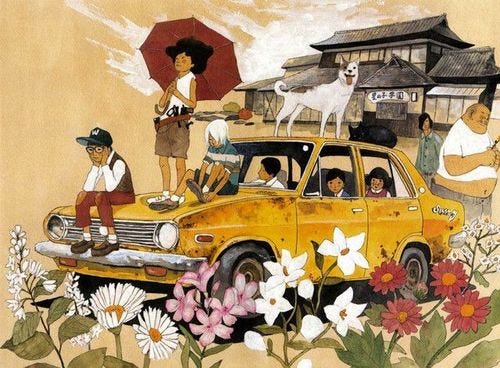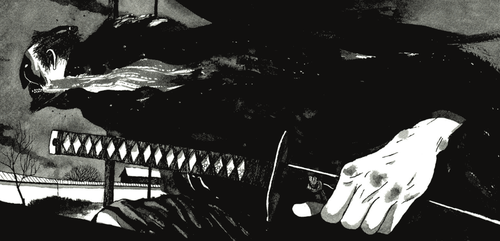Taiyō Matsumoto

Born and ’67 and raised in an orphanage, realizing he couldn’t become a soccer star Matsumoto turned to manga as a career. While touring through France in ’86 he encountered European BDs and even though he couldn’t read them [1] (not even just as graphic storytelling, since they were so text-heavy) he was enthralled by the style. And just as his greatest Japanese influence, Katsuhiro Otomo, his work turned into a fusion of Japanese storytelling with European influenced designs and rendering techniques (just look at the continuous hatching that turn into pointillism.).
Feeling the need to distance himself from the earlier generation he adopted a much more graphical and cartoony style as opposed to the much more realistic one[2]. Doing so, his early comics looked a lot less like Moebius or Otomo and more like Munoz going for distorted perspectives and heavy inks. But his style kept evolving from project to project incorporating techniques or exorcising others. No. 5 feels a lot as his way of getting Moebius out of his system and the washes he developed in Takemitsuzamurai are put to great use in Sunny.

While abandoning soccer, he never really left sports alone. Most of the comics from the first half of his career are sport dramas. Straight is a two volume manga about a relief pitcher, ZERO is a two volume manga about a boxer, Ping Pong is a five volume manga about a team of table tennis players. He enjoys doing sports comics because he likes portraying action and he feels that it can be done a lot more naturally than in other genres[3]. I think it speaks volumes about his versatility that one of the best (if not his best) comics, Sunny, is almost devoid of action in place of atmosphere and character interactions.

Probably because one of the things that makes his action so affecting is the way he sets up the space the characters inhabit and navigate. The school(s) from Blue Spring, Treasure Town from Black and White (Tekkonkinkreet), the school from GoGo Monster or the Orphanage from Sunny (and Sunny itself), they all have character and weight and feel palpable.
A lot of his comics have been adapted into movies, but I haven’t seen any even though I’m curious how they turned out.
1. “It’s hard to say for sure since I can’t actually read them, but I felt like they didn’t really have any rhythm. I thought there was a lot of text crammed into all the speech bubbles.”, Taiyō Matsumoto about the main differences between BD and manga in a Timeout interview from 2013 http://www.timeout.jp/en/tokyo/feature/7801/Interview-Taiyo-Matsumoto
2. “I guess the star for my generation was Katsuhiro Otomo. I remember when I was just starting out, feeling this pressure to come down on one side — do you like Otomo, or not? He was just so influential. There were people who didn’t want to admit they’d even read him, they so hated the thought of being accused of his influence. So I decided that I for one would admit to liking his work.” Taiyō Matsumoto in a discussion with Inio Asano and Keigo Shinzo from Monthly Spirits. https://mangabrog.wordpress.com/2014/06/14/taiyo-matsumoto-with-inio-asano-and-keigo-shinzo/
3. “I like comics with action especially in a serialized comic. Specifically, I prefer to draw sports stories where the action can be depicted more naturally, as compared to something like a gangster action comic. Another reason I prefer to draw sports comics is that I enjoy drawing the little details that belong to sports, like a catcher’s mitt or the number on a player’s back in a baseball manga.” Taiyō Matsumoto in an interview for Tokyo Cool from 1995 http://comics212.net/?p=1832
Originally published here
